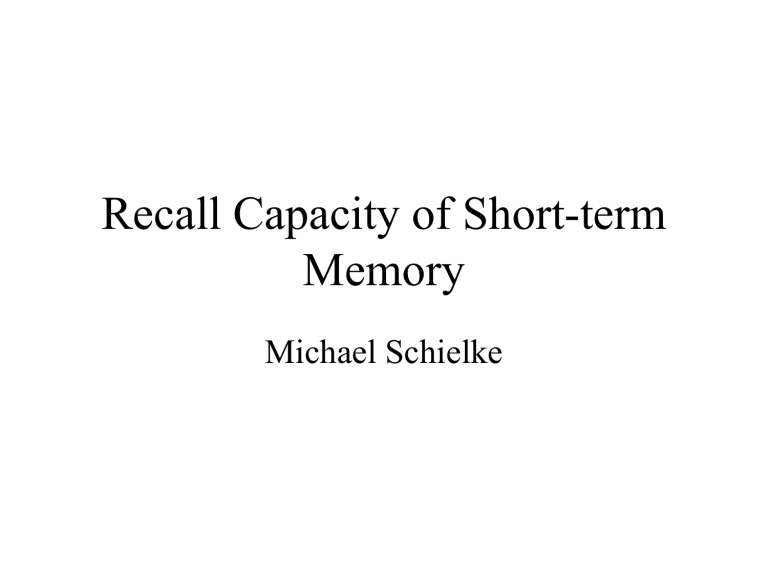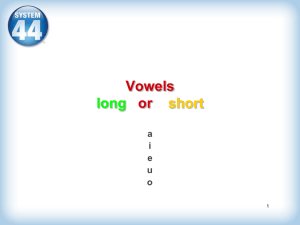Recall Capacity of Short

Recall Capacity of Short-term
Memory
Michael Schielke
Objective
• Determine whether short-term memory store is based on time or chunks
• Determine capacity of short-term store
Baddeley vs. Cowan
Baddeley
• 1-2second working memory
• Memory stores over a span of time
• Memory Decay
• Phonological loop model
Cowan
• 4+/-1 chunk capacity
• Overload
• Effect of long-term memory
• Focus of attention
Baddeley’s Time Span Model
• Rate of Decay
– Short-term memory fades over a few seconds
– Rate of decay experiment
– Subsequent silence vs. speech
• Phonological Loop Model
– Evolved system to facilitate language acquisition
– Phonological store of 1 to 2 seconds
– Maximum capacity before fading occurs
Cowan’s Chunking Model
• What makes up a chunk?
– Effect of Long-term memory
• Overload
– More information than can be recalled
• Focus of Attention
– Items must exist in the focus of attention directly preceding the response
– Serial recall test
The Study
• Method
– Syllabic chunks based on unfamiliar language
– Stimuli recorded in Japanese by Native speaker
• 3-10 syllables (.45-1.6seconds)
• Two words from each set
– Items played to participants once each
• Participants repeat what is heard
• Correct and incorrect repetition recorded
– 25 participants with no Japanese exposure
• 14 males/11 females
• Age 15-65
• 19 monolingual English/ 6 Bilinguals (English +)
Stimuli
• 3 Syllables
• waraji, hakari
• 4 Syllables
• kurogane, samehada
•
5 Syllables
• tarachineno, kusamakura
• 6 Syllables
• zashikiwarashi, warabukiyane
•
7 Syllables
• tanabatamatsuri, hokosugibayashi
• 8 Syllables
• kamakuramonogatari, yamagoyamitorizu
•
9 Syllables
• harimayabashimeguri, kikagakutekizushiki
• 10 Syllables
• kamagasakiyudetamago, hakodateyamashikimado
Results
Chunking
40%
30%
20%
10%
0%
90%
80%
70%
60%
50%
3 4 5 6 7 8 9 10 1.6
sec
120%
100%
80%
60%
40%
20%
0%
Time Elapsed
Results cont.
• 84% recall of 3 and 4 syllables
• 48% recall of 5 syllables
• Highest probable recall time .715%
Monolinguals vs. Bilinguals
Chunks
100%
90%
80%
70%
60%
50%
40%
30%
20%
10%
0%
3 5 7 9
Monolinguals Bilinguals
1.6sec
120%
100%
80%
60%
40%
20%
0%
Time Elapsed
Monolinguals Bilinguals
Monolingual vs. Bilingual
Results
• Higher level of recall by native bilinguals
– 32% increase in recall of 3-4 syllable words
– Increased recall capacity on 5-10 syllable words
Discussion
• Influence of Chunks and Time
– As word length increases, recall decreases
• Possible Explanations
– Focus of Attention (Cowen 2001)
– Rate of Decay (Baddeley 1998)
• Monolingual vs. Bilingual Recall
– Phonological Inventory?
Conclusion
• Support towards Cowan’s 4+/-1 Model
• Evidence for a 1-second working memory
• Additional research needed to reveal contrast between monolingual and bilingual recall probability.







